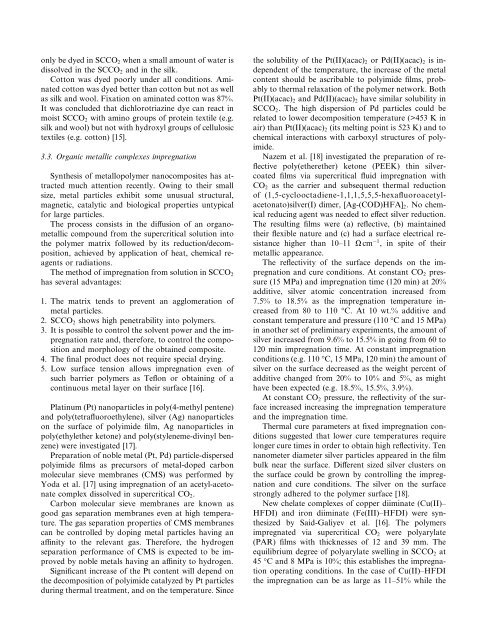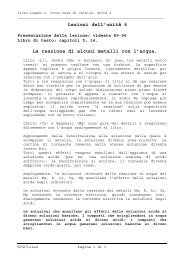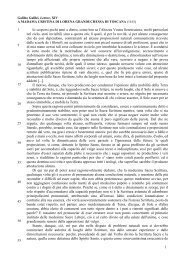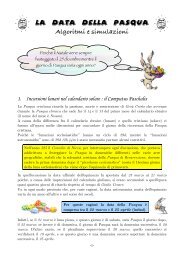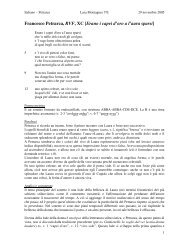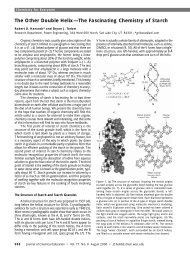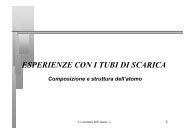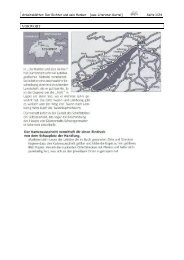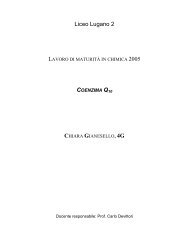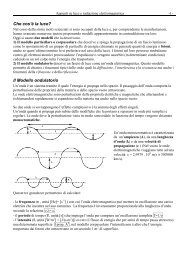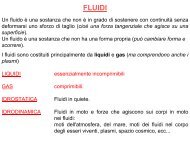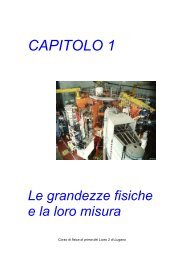Supercritical impregnation of polymers - ZyXEL NSA210
Supercritical impregnation of polymers - ZyXEL NSA210
Supercritical impregnation of polymers - ZyXEL NSA210
You also want an ePaper? Increase the reach of your titles
YUMPU automatically turns print PDFs into web optimized ePapers that Google loves.
402 I. Kikic, F. Vecchione / Current Opinion in Solid State and Materials Science 7 (2003) 399–405<br />
only be dyed in SCCO 2 when a small amount <strong>of</strong> water is<br />
dissolved in the SCCO 2 and in the silk.<br />
Cotton was dyed poorly under all conditions. Aminated<br />
cotton was dyed better than cotton but not as well<br />
as silk and wool. Fixation on aminated cotton was 87%.<br />
It was concluded that dichlorotriazine dye can react in<br />
moist SCCO 2 with amino groups <strong>of</strong> protein textile (e.g.<br />
silk and wool) but not with hydroxyl groups <strong>of</strong> cellulosic<br />
textiles (e.g. cotton) [15].<br />
3.3. Organic metallic complexes <strong>impregnation</strong><br />
Synthesis <strong>of</strong> metallopolymer nanocomposites has attracted<br />
much attention recently. Owing to their small<br />
size, metal particles exhibit some unusual structural,<br />
magnetic, catalytic and biological properties untypical<br />
for large particles.<br />
The process consists in the diffusion <strong>of</strong> an organometallic<br />
compound from the supercritical solution into<br />
the polymer matrix followed by its reduction/decomposition,<br />
achieved by application <strong>of</strong> heat, chemical reagents<br />
or radiations.<br />
The method <strong>of</strong> <strong>impregnation</strong> from solution in SCCO 2<br />
has several advantages:<br />
1. The matrix tends to prevent an agglomeration <strong>of</strong><br />
metal particles.<br />
2. SCCO 2 shows high penetrability into <strong>polymers</strong>.<br />
3. It is possible to control the solvent power and the <strong>impregnation</strong><br />
rate and, therefore, to control the composition<br />
and morphology <strong>of</strong> the obtained composite.<br />
4. The final product does not require special drying.<br />
5. Low surface tension allows <strong>impregnation</strong> even <strong>of</strong><br />
such barrier <strong>polymers</strong> as Teflon or obtaining <strong>of</strong> a<br />
continuous metal layer on their surface [16].<br />
Platinum (Pt) nanoparticles in poly(4-methyl pentene)<br />
and poly(tetrafluoroethylene), silver (Ag) nanoparticles<br />
on the surface <strong>of</strong> polyimide film, Ag nanoparticles in<br />
poly(ethylether ketone) and poly(styleneme-divinyl benzene)<br />
were investigated [17].<br />
Preparation <strong>of</strong> noble metal (Pt, Pd) particle-dispersed<br />
polyimide films as precursors <strong>of</strong> metal-doped carbon<br />
molecular sieve membranes (CMS) was performed by<br />
Yoda et al. [17] using <strong>impregnation</strong> <strong>of</strong> an acetyl-acetonate<br />
complex dissolved in supercritical CO 2 .<br />
Carbon molecular sieve membranes are known as<br />
good gas separation membranes even at high temperature.<br />
The gas separation properties <strong>of</strong> CMS membranes<br />
can be controlled by doping metal particles having an<br />
affinity to the relevant gas. Therefore, the hydrogen<br />
separation performance <strong>of</strong> CMS is expected to be improved<br />
by noble metals having an affinity to hydrogen.<br />
Significant increase <strong>of</strong> the Pt content will depend on<br />
the decomposition <strong>of</strong> polyimide catalyzed by Pt particles<br />
during thermal treatment, and on the temperature. Since<br />
the solubility <strong>of</strong> the Pt(II)(acac) 2 or Pd(II)(acac) 2 is independent<br />
<strong>of</strong> the temperature, the increase <strong>of</strong> the metal<br />
content should be ascribable to polyimide films, probably<br />
to thermal relaxation <strong>of</strong> the polymer network. Both<br />
Pt(II)(acac) 2 and Pd(II)(acac) 2 have similar solubility in<br />
SCCO 2 . The high dispersion <strong>of</strong> Pd particles could be<br />
related to lower decomposition temperature (>453 K in<br />
air) than Pt(II)(acac) 2 (its melting point is 523 K) and to<br />
chemical interactions with carboxyl structures <strong>of</strong> polyimide.<br />
Nazem et al. [18] investigated the preparation <strong>of</strong> reflective<br />
poly(etherether) ketone (PEEK) thin silvercoated<br />
films via supercritical fluid <strong>impregnation</strong> with<br />
CO 2 as the carrier and subsequent thermal reduction<br />
<strong>of</strong> (1,5-cyclooctadiene-1,1,1,5,5,5-hexafluoroacetylacetonato)silver(I)<br />
dimer, [Ag-(COD)HFA] 2 . No chemical<br />
reducing agent was needed to effect silver reduction.<br />
The resulting films were (a) reflective, (b) maintained<br />
their flexible nature and (c) had a surface electrical resistance<br />
higher than 10–11 X cm 1 , in spite <strong>of</strong> their<br />
metallic appearance.<br />
The reflectivity <strong>of</strong> the surface depends on the <strong>impregnation</strong><br />
and cure conditions. At constant CO 2 pressure<br />
(15 MPa) and <strong>impregnation</strong> time (120 min) at 20%<br />
additive, silver atomic concentration increased from<br />
7.5% to 18.5% as the <strong>impregnation</strong> temperature increased<br />
from 80 to 110 °C. At 10 wt.% additive and<br />
constant temperature and pressure (110 °C and 15 MPa)<br />
in another set <strong>of</strong> preliminary experiments, the amount <strong>of</strong><br />
silver increased from 9.6% to 15.5% in going from 60 to<br />
120 min <strong>impregnation</strong> time. At constant <strong>impregnation</strong><br />
conditions (e.g. 110 °C, 15 MPa, 120 min) the amount <strong>of</strong><br />
silver on the surface decreased as the weight percent <strong>of</strong><br />
additive changed from 20% to 10% and 5%, as might<br />
have been expected (e.g. 18.5%, 15.5%, 3.9%).<br />
At constant CO 2 pressure, the reflectivity <strong>of</strong> the surface<br />
increased increasing the <strong>impregnation</strong> temperature<br />
and the <strong>impregnation</strong> time.<br />
Thermal cure parameters at fixed <strong>impregnation</strong> conditions<br />
suggested that lower cure temperatures require<br />
longer cure times in order to obtain high reflectivity. Ten<br />
nanometer diameter silver particles appeared in the film<br />
bulk near the surface. Different sized silver clusters on<br />
the surface could be grown by controlling the <strong>impregnation</strong><br />
and cure conditions. The silver on the surface<br />
strongly adhered to the polymer surface [18].<br />
New chelate complexes <strong>of</strong> copper diiminate (Cu(II)–<br />
HFDI) and iron diiminate (Fe(III)–HFDI) were synthesized<br />
by Said-Galiyev et al. [16]. The <strong>polymers</strong><br />
impregnated via supercritical CO 2 were polyarylate<br />
(PAR) films with thicknesses <strong>of</strong> 12and 39 mm. The<br />
equilibrium degree <strong>of</strong> polyarylate swelling in SCCO 2 at<br />
45 °C and 8 MPa is 10%; this establishes the <strong>impregnation</strong><br />
operating conditions. In the case <strong>of</strong> Cu(II)–HFDI<br />
the <strong>impregnation</strong> can be as large as 11–51% while the<br />
content <strong>of</strong> pure copper in film is as large as 1.3–6.3 wt.%;


